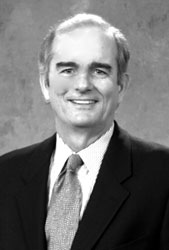|
 College
President Series: College
President Series:
Gregory H. Williams: President, City College
by Marie
Holmes
“My
father somehow developed this great thirst for knowledge,”
says Gregory H. Williams, who became City College’s 11th
President on August, 2001.
“Thirst”
is certainly an understatement. Williams’ father, an African-American
living in Indiana, was so determined to go to college that he
spent his nights studying by the light of a coal oil lamp. “In
the 1930’s,” explains Williams, “African-American
high school students in the State of Indiana were relegated
to technical programs; the boys in Industrial Arts, the girls
in Home Economics.”
When his father was a senior in high school he spent his schooldays
constructing a house adjacent to the campus of Ball State University,
where President Williams eventually earned his undergraduate
degree. Too poor to spend ten cents on bus fare, Williams would
pass the house his father had built every day on his walk to
class, filled both with pride and indignation upon seeing this
landmark to his father’s struggle. When Williams’
father applied to Howard University his application was rejected
for lack of academic coursework, a result of being in the technical
program. Determined to go to college, however, his father returned
to high school for another year in order to earn the academic
credits required for admission. He studied for a year at Howard,
although he never earned his degree. 
“The
obstacles he faced didn’t extinguish his desire for education
and his determination to inculcate that in my brother and me,”
Williams said. A fine basketball player, Williams wanted to
spend one summer sharpening his court skills. His father, however,
required him to attend summer school. He believed that education
would one day open doors for me that were closed to him, and
he was right,” says Williams. His father encouraged him
to read and they often took trips together to the Christian
Science reading room. This quest for education and knowledge
provided some stability and direction for Williams amidst the
racial turmoil of his childhood, which is detailed in his gripping
memoir, Life on the Color Line: The True Story of A White Boy
Who Discovered He Was Black.
Now an experienced college administrator with five earned degrees,
including a J.D. and Ph.D. from The George Washington University,
as well as three honorary doctorates, Williams is well aware
that his experiences are not merely anecdotes of life in the
racially-divided America of the first half of the 20th century.
“Over
three quarters of our students are members of minority groups
and over half come from families with incomes of under $25,000
a year,” says Williams. “According to the latest
edition of U.S. News and World Report’s America’s
Best Colleges, City College is the most diverse campus
in America where Blacks are the largest minority group,”
he added. Blacks make up around 30 percent of CCNY’s
student population, while Hispanics account for 26 percent and
Asians around 14 percent. “That is what makes City College
the most significant ladder of upward mobility in New York City
and also in America,” Williams said.
He may well be correct. As the flagship campus of The City University
of New York, with increasing enrollments now topping 12,000
City College constitutes the core of the nation’s largest
urban university.
Like colleges across the country, new procedures impacting immigrants
without documentation have caused difficulties for some students.
Since 1989 The City University
has permitted students who could prove residency in New
York State but did not have official immigration documentation
to pay the resident tuition rate of $3200 per year. When administrators
realized that this process was technically in violation of 1996
federal legislation, the policy was put in jeopardy. On August
9th, however, Governor George Pataki visited CCNY to sign the
Immigrant Student Legislation Act, which allows New York City
high school graduates without legal immigration status to continue
to pay resident tuition rates at both the City and State Universities.
“These
students don’t have the resources to pay out-of-state
tuition and that would [have] effectively closed the door to
higher education for them,” says Williams, who noted that
City College was founded over 150 years ago to educate the children
of the working class and immigrants.
He cited the example of a recent student who was raised in a
rural mountain region of Mexico, came to New York, washed dishes
during the day and studied English at night. “He eventually
enrolled at City College, has an outstanding academic record
and plans to earn a Ph.D.”
Williams understands what it is to overcome obstacles in order
to receive an education. While attending college he worked
full-time as a deputy sheriff, often more than 40 hours per
week. “I managed to graduate in four
years so I know it can be done. I can identify with the
struggles of today’s City College students, most of whom
must work while attending college. I tell them not to
get discouraged, and that if they work hard and keep their goal
in mind they will succeed.”
The most popular major at City College is psychology, Williams
estimates, while engineering and architecture are also student
favorites. CCNY boasts the only public schools of engineering
and architecture in New York City. Other popular programs include
Sonic Arts (sound engineering)and a new undergraduate major
in biomedical engineering.
“What
City College has demonstrated,” he says, making no effort
to hide his gentle Mid-Western accent, “is that you can
have a very diverse environment combined with very high quality
programs.”#

Education
Update, Inc., P.O. Box 20005, New York, NY 10001.
Tel: (212) 481-5519. Fax: (212) 481-3919.Email: ednews1@aol.com.
All material is copyrighted and may not be printed without express
consent of the publisher. © 2002.
|
